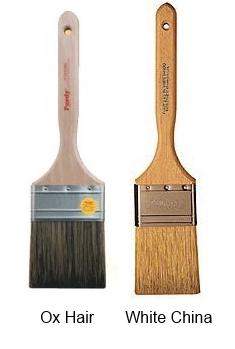Applying French Polish with a Brush
Media Gallery
Applying French Polish With a Brush is More Difficult Than Using a Pad
There are some furniture restoration professionals who will say that applying a French polish with a brush is not the correct way to achieve this type of finish. But, this is not necessarily true. French polish can be applied to wood using a paintbrush if it is done correctly and quickly.
What is French Polish?
French polish is not a substance that is applied to wood. It is a technique for adding shellac as a finish. French polishing results in a glass-like and glossy finish that is unique and exquisite. It is not the most common finish seen in modern times because it is a skill that takes quite a while to achieve. These days, furniture manufacturers are not necessarily into producing anything that takes a long time – – they are often more concerned about quickly producing furniture in a mass production fashion. French polished is something that requires a true desire to achieve a specific look. For those that want the unique look of a French polished shellac finish, it is important to remember the process is tedious and requires knowledge and skill.
Brush vs. Pad
Most people with experience in French polishing say that applying shellac with a pad is easier than using a brush. This has a lot to do with the fact that shellac dries very quickly and by the time a brush applies a layer of shellac, the surface is almost instantaneously dry! This prevents the ability for a person to go back and fix uneven or messy areas. When shellac is applied with a pad, there is very little room for error because the shellac is released from the pad in a very thin layer.
Using both a brush and a pad to apply a French polish on wood furniture requires an acquired skill. The two application methods are similar but require patience and technique. With some types of wood, you may choose to use both a brush and a pad. A pad is usually recommended for flat surfaces, but you might want to switch to a brush for areas that are ornate or hard to reach. Depending on how quickly the shellac dries, it may also be possible to apply it to flat surfaces with a brush and then use a pad to smooth the layers.
Common Problems When Using a Brush
There are both positives and negatives associated with both brushes and pads when applying a French polish. With a brush, the most obvious negative is associated with drops of shellac falling off the brush as it is moved over the piece of furniture. This may not seem like a big deal, but drops of shellac that fall on the furniture cannot be easily wiped away. Since shellac dries very quickly, by the time you reach for a rag to clean the mess, the drops have already dried. Drops of shellac that have dried on the surface of the furniture can be repaired, but fixing this type of mistake takes time. Another problem is heavy edges as the shellac is applied. In both cases be careful during application.
Type of Brushes
When applying French polish with a brush, it is important to use the correct type. A brush that is able to hold a substantial amount of shellac is the type that will work the best. Natural bristle brushes – specifically those made of white china bristles or ox hair are optimal. Paint brushes made of natural materials are more expensive than brushes with synthetic bristles, but they are much easier to use and they will yield optimal results. Natural bristle brushes that are used to apply shellac do not have to be thrown away after they are used. They can be cleaned and used for applying subsequent layers of shellac or they can be used for different projects altogether.
Final Touches
After all coats of shellac are carefully applied the final step is to rub-out or buff your new finish. This will remove any brush lines remaining on the surface and produce a glass like finish. This isn’t absolutely necessary as long as you like the current finish that brushing created.




